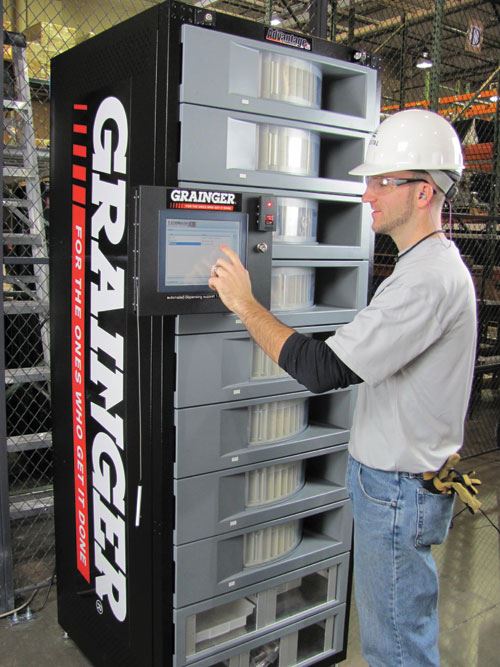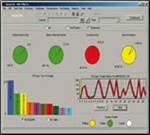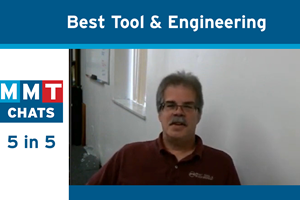Take Costs Out with Aggressive Inventory Management
A look at three MRO inventory management approaches—stocked, managed and leveraged—to help you learn where your inventory management stands and where you can take it.
This year U.S. businesses, which includes those niche businesses in the mold manufacturing market, will spend $110 billion on maintenance, repair and operating (MRO) materials—products ranging from abrasives to cutting tools to fasteners–and of that $110 billion, approximately $12 billion1 will sit on shelves and never get used. A study2 estimates more than half of U.S. businesses are not effectively managing their MRO supplies, leaving them with dead, obsolete, and most importantly, budget-draining inventory.
Not a pretty picture, but a rich opportunity for mold manufacturing professionals to take costs out of their business through a more aggressive approach to inventory management. Studies show that improving inventory management processes can help businesses reduce spending by as much as 25 percent.
How do you know where your inventory management stands and where you can take it? To help, we took lessons learned from more than 500 organizations and identified three primary approaches to MRO inventory management—stocked, managed and leveraged.
Evolving Your Approach to Inventory Management
Stocked is the most basic approach to MRO inventory management. It is mainly reactive and items are added to inventory for convenience or to avoid stock-outs. All MRO materials are thought of as an unrecoverable cost and management pays little attention to them, buying, storing and issuing supplies to employees in an ad-hoc fashion.
Without controls in place or data to understand how often an item is used, you can’t predict demand and inventory continues to grow. This encourages a move toward the next evolution – a managed approach.
A managed approach helps control costs by using process and inventory data to help with decision making. In this approach, MRO materials are considered an operational expense that can be actively managed and controlled.
The first step in moving to a managed approach is investing in building the right data. Data is what makes MRO inventory manageable; it helps you understand your demand and usage patterns so you can optimize inventory levels.
To test the quality of your data, pick an item and see if you can provide answers to basic questions, such as: What is it and where can you find it? When is it used and how much of it is needed? Why is it in stock and who supplies it? The more of these questions you can answer, the more effective your inventory management.
You’ll also need to further define the processes you use to manage MRO materials, including how you stock, consume, analyze and recover inventory. Standardizing these processes and ensuring they are consistently performed will provide you quality inventory data and increase efficiency.
While the managed approach is effective, some employees may believe the controls slow them down, so they create their own “private” inventory. Over time, tension can build as the process breaks down and data is deemed unreliable. This encourages the shift toward a leveraged approach.
Leveraged—the optimal approach—considers MRO inventory as a strategic component of the business and an investment with recoverable value. This approach requires materials be organized and issued in a disciplined manner, but most importantly, this approach requires creating accountability and providing a reason to take action.
Accountability is created when relevance, influence and incentive all converge, but an organization cannot expect to bring these three elements together for every role involved with MRO materials. For example, improved inventory management may be relevant for a storeroom manager, but a lack of influence prevents the manager from implementing change. A maintenance manager may have a high degree of influence, but no incentive to reduce for the value of materials held in stock. To overcome this fragmented accountability, many organizations create a cross-functional team responsible for all elements of inventory management or establish a role tied solely to inventory management.
By executing a leveraged approach, you will see the most improvement to your company’s bottom line.
Solutions and Technology to Get You There
Once your organization understands the opportunity that comes from effective inventory management, you will want to explore solutions and technologies that will assist you in effectively leveraging your inventory.
Depending on scale and need, manufacturing environments can benefit from a wide range of solutions, from very simple to complex, to achieve best-in-class results; however, because moldmaking professionals frequently require access to very high-dollar consumables, there are a few specific inventory management solutions, some of which use more complex technology, that will be the most effective in this specific setting.
One solution that is particularly effective for a larger, moldmaking environment is dispensing machines. A dispensing solution is a customized, automated machine that controls usage of consumable items located at point-of-use locations, which helps improve employee productivity by limiting extra trips around the facility to obtain items. A dispensing solution can also include a locker system for the checking in and out and tracking of valuable tools (see Figure 1).
To access the products within the machine, employees will, for example, swipe their ID badge or enter an employee ID via the device that is attached to the machine. The machine then tracks usage with transaction detail and can summarize data at the item, employee and department level. This data can then be leveraged by an organization’s purchasing team to make more strategic purchasing decisions. The technology associated with the machine also enables automated reordering to help reduce stock-outs and purchase order processing costs.
Dispensing is one solution example, and there is a wide variety of other options to consider including:
• Onsite services: A vendor or supplier will offer onsite support and will take accountability for your inventory management process. An onsite inventory management professional will spend time at your facility keeping track of inventory, ordering necessary items and putting away all products. This is a good option for those organizations that aren’t able to allocate the time of a dedicated in-house staff member to manage inventory.
• Scanning technology: Leveraged with a customer managed inventory replenishment solution, scanners provide a simple point-and-click single bar code reading system to automate the reordering of stocked items. Working with a partner that offers this technology helps to streamline purchasing as information scanned can be uploaded directly into an online purchasing system (see Figure 2).
A lot to consider, right? To determine what may be the best fit for your business, start the exploration process with a reliable solutions partner that offers consulting services to make the process easier and ensure you're selecting the right solution as no one solution can meet the needs of every organization.
Follow the Road to Success
Understanding your current approach to inventory management and embracing a solution that meets the specific needs of your organization will allow you to shift more of your existing resources toward your core moldmaking business. For some manufacturing businesses this shift can represent the difference between a profit and a loss.
References
1$12 billion figure based off the current estimate that $110 billion will be spent on MRO this year. Of that figure, 50 percent is attributed to planned purchases. Leading research estimates that 20-30 percent of planned purchases then go unused.
2Study conducted by Grainger’s Consulting Services.
Related Content
Hands-on Workshop Teaches Mold Maintenance Process
Intensive workshop teaches the process of mold maintenance to help put an end to the firefighting culture of many toolrooms.
Read MoreMMT Chats: 5 in 5 with Best Tool and Engineering
MoldMaking Technology Editorial Director Christina Fuges reveals 5 best practices for improving efficiencies within shops...in 5 minutes. Our guest is Joe Cherluck, President of Best Tool and Engineering in Clinton Township, Michigan. This episode is brought to you by ISCAR.
Read MoreMMT Chats: Acquisition Trends and Lessons for Mold Builders
Jim Berklas is a former full-time M&A lawyer for several of the largest private equity firms in the country and has 25 years of M&A experience and 200 closed transaction. Today, he is founder and M&A Leader with Augmented Industry Services. He joins me for this MMT Chat on mergers and acquisitions trends and strategies within in the mold manufacturing industry. This episode is brought to you by ISCAR with New Ideas for Machining Intelligently.
Read MoreQuestions and Considerations Before Sending Your Mold Out for Service
Communication is essential for proper polishing, hot runner manifold cleaning, mold repair, laser engraving and laser welding services.
Read MoreRead Next
How to Solve Common Inventory Management Problems Related to Tooling
A practical look at what to consider when purchasing client/server inventory management software and how to implement such a program, as well as why and how it can benefit mold manufacturing operations.
Read MoreAre You a Moldmaker Considering 3D Printing? Consider the 3D Printing Workshop at NPE2024
Presentations will cover 3D printing for mold tooling, material innovation, product development, bridge production and full-scale, high-volume additive manufacturing.
Read MoreReasons to Use Fiber Lasers for Mold Cleaning
Fiber lasers offer a simplicity, speed, control and portability, minimizing mold cleaning risks.
Read More_970x90 4.png;maxWidth=970;quality=90)













.jpg;maxWidth=300;quality=90)


_300x250 4.png;maxWidth=300;quality=90)






_300x250 3.png;maxWidth=300;quality=90)







.jpg;maxWidth=970;quality=90)